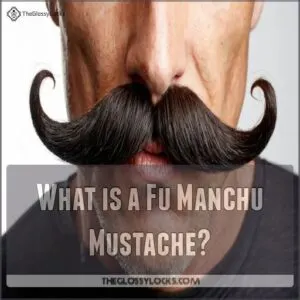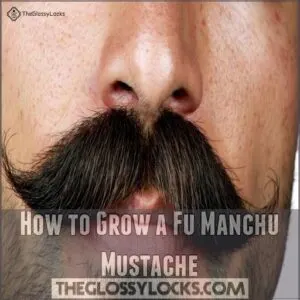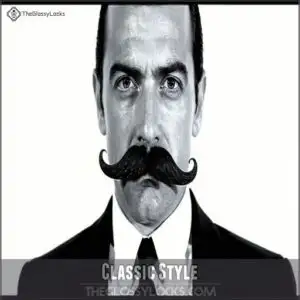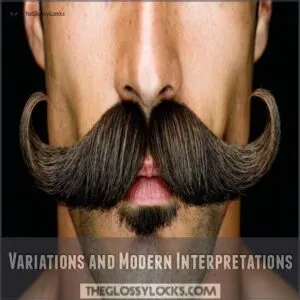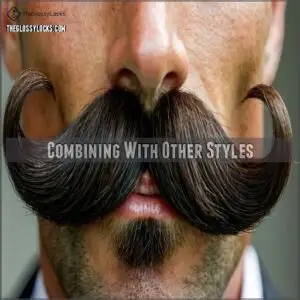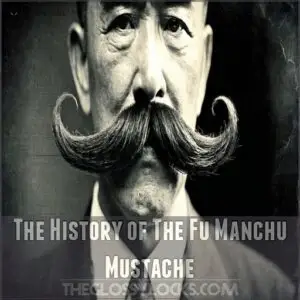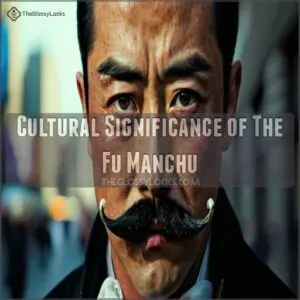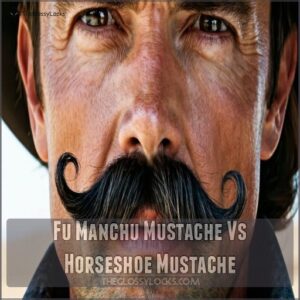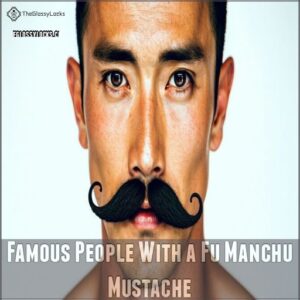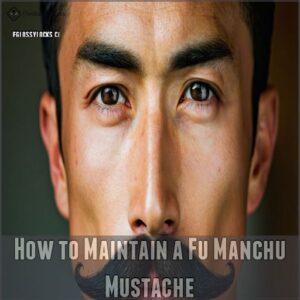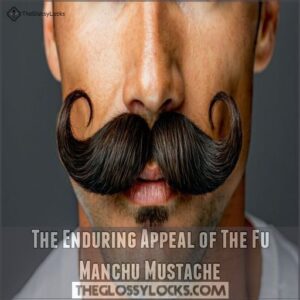This site is supported by our readers. We may earn a commission, at no cost to you, if you purchase through links.
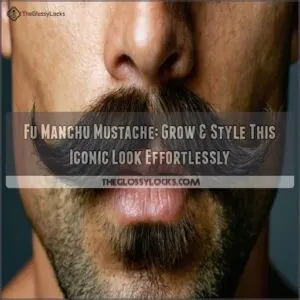 So, you’re curious about the Fu Manchu mustache? It’s a classic look, think long, elegant tendrils growing downward from the corners of your mouth. It’s pretty distinctive, and you’ll definitely stand out from the crowd. Think of it as a statement, a bold declaration of your unique style.
So, you’re curious about the Fu Manchu mustache? It’s a classic look, think long, elegant tendrils growing downward from the corners of your mouth. It’s pretty distinctive, and you’ll definitely stand out from the crowd. Think of it as a statement, a bold declaration of your unique style.
Growing one takes patience, but the results are worth it. You’ll need to let it grow, trim it regularly, and maintain a clean-shaven chin and upper lip.
There are tons of ways to style a Fu Manchu; you can keep it neat and tidy or let it get a little wild. Want to know the secrets to mastering this iconic look? Let’s explore!
Table Of Contents
- Key Takeaways
- What is a Fu Manchu Mustache?
- What Does a Fu Manchu Mustache Look Like?
- How to Grow a Fu Manchu Mustache
- Styling a Fu Manchu Mustache
- The History of The Fu Manchu Mustache
- Cultural Significance of The Fu Manchu
- Fu Manchu Mustache Vs Horseshoe Mustache
- Famous People With a Fu Manchu Mustache
- How to Maintain a Fu Manchu Mustache
- The Enduring Appeal of The Fu Manchu Mustache
- Frequently Asked Questions (FAQs)
- How do you grow a Fu Manchu mustache?
- What is a Fu Manchu moustache?
- How do you style a Fu Manchu moustache?
- What is a Fu Manchu?
- What is a fu manchu beard?
- Is a Fu Manchu mustache a horseshoe mustache?
- Why is it called a Fu Manchu mustache?
- Who has a Fu Manchu mustache?
- How do you grow Fu Manchu mustache?
- Why is it called a fu manchu mustache?
- What is the difference between a horseshoe mustache and a Fu Manchu?
- What is the stereotype of Fu Manchu?
- Is Fu Manchu Chinese or Japanese?
- What face shapes suit a Fu Manchu best?
- Can women wear a Fu Manchu style?
- How long does it take to grow?
- Are there tips for keeping it clean?
- What products help style a Fu Manchu?
- Conclusion
Key Takeaways
- You’ll need patience and consistent grooming to grow and maintain a Fu Manchu mustache.
- The Fu Manchu’s history is complex, encompassing cultural appropriation and modern reclamation.
- You can style a Fu Manchu in various ways, from classic to modern interpretations, even combining it with other beard styles.
- Famous figures have sported the Fu Manchu, showcasing its enduring appeal as a bold fashion statement.
What is a Fu Manchu Mustache?
If you’ve ever spotted those long, dangling mustache ends that give off a sense of rebellious flair, you’ve seen a Fu Manchu.
Named after a notorious fictional character, this mustache style combines dramatic length with personality, creating a look that’s as unique as it’s bold.
Origins and Etymology
Born from the pages of Sax Rohmer’s novels, the Fu Manchu mustache takes center stage as the trademark of Dr. Fu Manchu, the notorious Chinese villain in "The Brides of Fu Manchu."
This facial feature became emblematic of cultural appropriation, celebrating individuality while grappling with stereotypes tied to Chinese culture and the fictional character’s villainous allure.
Physical Characteristics
If you’re eyeing the Fu Manchu mustache, picture whiskers that grow long and straight, often stretching beyond the chin.
It’s like having the handlebars of a bicycle on your face, only cooler.
This stache boasts a sleek shape with a clean upper lip gap, often flaunting a unique thickness and texture that screams individuality.
Cultural Associations
Many associate the Fu Manchu mustache with specific cultures, but its history is complex.
It’s been linked to Chinese culture, thanks largely to Sax Rohmer’s fictional Chinese villain, fueling harmful Asian stereotypes.
The style has also become a symbol of racial identity.
However, its roots aren’t solely tied to China; think Cossacks and their oseledets!
Here are some key points to keep in mind:
- The Fu Manchu’s image has been warped.
- Cultural appropriation is a real concern.
- Modern interpretations often reclaim it.
- Understanding its historical context is key.
What Does a Fu Manchu Mustache Look Like?
Imagine the Fu Manchu mustache, a distinctive facial hair style that’s all about length and shape.
Unlike your average mustache, this style features tendrils that cascade gracefully beyond the chin, making it a bold fashion statement.
For a more refined look, consider pairing it with the classic handlebar mustache, a style requiring wax for precise shaping.
It’s not just another one of those everyday mustache styles; it’s a masterpiece of individuality.
Imagine long, straight lines defining your visage, almost like whiskers on a wise old lion.
The Fu Manchu mustache variations can turn heads, adding an exotic flair to your look.
Whether you’re channeling your inner artist or simply embracing rebel charm, the Fu Manchu is your perfect ally in the quest for facial hair freedom. To complement this iconic look, consider growing mutton chops, a classic style that features long sideburns extending to the bottom of the chin, which can be achieved by following a guide on how to shave mutton chops.
Give it a whirl!
How to Grow a Fu Manchu Mustache
Growing a Fu Manchu mustache is like nurturing a piece of art, requiring patience and a bit of dedication.
You’ll start by ensuring your cheeks and chin are clean-shaven while letting the mustache extend beyond your chin.
All the while, keep it neatly trimmed and styled to maintain its iconic look.
Pre-Growth Preparation
Before growing your Fu Manchu, prep your canvas.
Start with facial hair skin care to guarantee healthy hair growth.
Regular exfoliation helps, while beard oils and mustache wax keep skin smooth and facial hair soft.
Mustache shaping begins with a balanced diet and patience.
Remember, a fresh foundation sets the stage for your stylish journey with mustache growth and trimming.
Growing The Mustache
Kicking off your Fu Manchu journey? Patience and persistence are essential.
Let your mustache grow long and lean, resisting the urge to trim too soon.
You may also want to explore other iconic styles like the [handlebar mustache styles](https://theglossylocks.com/how-to-shave-a-handlebar-mustache/ that have been popular throughout history.
Fuel its growth with nourishing beard oil and savor the anticipation as it inches toward that legendary look.
Remember, mustache styling takes time, so embrace the slow burn to power up your style game.
Trimming and Maintenance
Alright, your Fu Manchu mustache deserves attention. Keep it sharp with these steps:
- Trim often: Use quality Fu Manchu mustache tools and keep stray hairs at bay.
- Shape smartly: Focus on clean lines for that iconic look.
- Maintain cleanliness: Use beard shampoo for freshness.
- Avoid mistakes: Over-trimming can ruin the style.
Enjoy your power mustache!
Styling a Fu Manchu Mustache
Styling a Fu Manchu mustache is all about balance and a dash of flair, letting you explore different looks like classic, Dali-inspired, or even combine it with other styles.
Whether you’re going for a straightforward classic appearance or mixing it up with modern variations, you can’t help but have some fun along the way.
Classic Style
Now that your Fu Manchu whiskers are growing nicely, let’s nail that classic style.
Think long, straight tendrils – picture a refined, old-school look.
To achieve this style, use a specialized Fu Manchu mustache comb to keep those stray hairs in check.
Keep those’stache ends neatly trimmed and even, letting them gracefully sweep past your chin.
It’s all about that elegant, symmetrical shape.
Remember, a little grooming goes a long way.
This classic Fu Manchu is timeless, a symbol of understated power.
Variations and Modern Interpretations
In today’s world, the Fu Manchu mustache has seen interesting twists, ditching conventions for flair.
Imagine these styles:
- Modern Fu Manchu: Longer tendrils with sleek finishes.
- Celebrity Fu Manchu: Inspired by popular figures, like a signature statement.
- Minimalist Approach: Shorter, tidier tendrils for subtle impact.
- Artistic Interpretation: Add color or patterns for a bold look.
Explore these styles to express your individuality!
Combining With Other Styles
Ever wondered how a Fu Manchu could shake up your style?
Combine it with a soul patch, goatee, or mutton chops for a dynamic look.
To maintain a neat look, you need to trim mustache symmetrically, working from the outside toward the center while growing and styling your Fu Manchu.
Check out the table below for unique pairings:
| Style Combination | Features | Style Note |
|---|---|---|
| Fu Manchu + Goatee | Central chin hair | Adds boldness |
| Fu Manchu + Mutton | Flairs out to jaw | Classic with a twist |
| Fu Manchu + Soul Patch | Small under-lip addition | Modern flair |
| Fu Manchu + Sideburns | Connects to cheeks | Full face impact |
| Fu Manchu + Handlebar | Upwards curling tendrils | Vintage charm |
Here, you’ve got choices to match your personality, making the Fu Manchu a versatile canvas for your facial hair creativity!
The History of The Fu Manchu Mustache
When you’re donning a Fu Manchu, you’re embracing a style with roots that trace back to the fictional mastermind, Dr. Fu Manchu, penned by Sax Rohmer in the 1920s.
This iconic mustache has journeyed through time, evolving from literary origins to a symbol of individuality that sparks both admiration and debate.
Literary Origins
The Fu Manchu mustache owes its literary origins to Sax Rohmer, who created the iconic Fu Manchu character.
This villain, with his distinctive mustache, became a symbol of mystery and intrigue.
For those who want to embody this iconic look, products like Fu Manchu mustache care items can be found at Fu Manchu Mustache.
Rohmer’s work, while imaginative, also reinforced Asian stereotypes, shaping the mustache’s cultural representation.
Despite its controversial nature, the Fu Manchu mustache’s history continues to influence style trends.
Cultural Significance
You’ve probably seen it – the Fu Manchu mustache, a style often associated with Asian stereotypes and cultural appropriation.
However, its origins are complex, rooted in literary history and identity politics.
Wearing a Fu Manchu mustache has been seen as a statement of rebellion, creativity, and individuality, challenging traditional notions of masculinity and beauty.
Evolution Over Time
Its symbolism’s changed quite a bit over time, hasn’t it?
From its association with villains in early 20th-century fiction to its modern embrace as a bold style statement, the Fu Manchu’s journey reflects shifting cultural attitudes.
Think of it as a mustache with its own fascinating history!
Fu Manchu trends show us how styles can evolve, representing different eras and personalities.
Today, it’s all about individual expression—and that’s pretty powerful.
Cultural Significance of The Fu Manchu
When you think of the Fu Manchu mustache, you might picture it as a fierce badge of rebellion and nonconformity.
Despite its controversial history of cultural stereotypes, many people have embraced it as a symbol of individuality and self-expression.
Style can be both personal and powerful.
Symbolism and Stereotypes
Imagine rocking a Fu Manchu mustache.
It’s not just about facial hair; it’s tangled with rich symbolism and Asian stereotypes.
Often seen as exotic or villainous, the Fu Manchu can be a double-edged sword, reflecting cultural appropriation concerns.
However, you’re stepping into a hairstyle that’s both powerful and rebellious, challenging traditional norms without losing its unique, storied history.
Activism and Reclamation
Once a symbol wrapped in stereotypes, the Fu Manchu mustache‘s journey has seen Asian communities reclaim it, turning the tables on cultural appropriation.
It’s about embracing Asian representation and identity politics, reshaping this facial hair style into a badge of reclaiming masculinity.
Why not wear your Fu Manchu beard with pride, challenging mustache stereotypes and rewriting the narrative?
Influence on Popular Culture
From film to music, the Fu Manchu mustache‘s cultural impact is undeniable.
Picture Christopher Lee’s chilling portrayal of Fu Manchu or Hulk Hogan’s iconic look.
This style has made its mark on historical figures and modern interpretations alike.
Whether seen on Jimmy Yang or Joe Namath, the Fu Manchu remains a bold statement of style and rebellion.
Fu Manchu Mustache Vs Horseshoe Mustache
When chatting about mustaches, distinguishing between the Fu Manchu and the Horseshoe styles can be a fun challenge.
You might say one’s for the mystery man and the other’s for the cowboy, but either way, understanding their differences helps you pick the perfect look.
Key Differences
Standing out with a distinct look, the Fu Manchu and the horseshoe mustache have key differences.
- Fu Manchu Mustache: Long tendrils hang below the chin, giving it a unique flair.
- Horseshoe Mustache: Ends at the jawline, like handlebars.
- Fu Manchu whiskers: Often emphasize individuality and rebellion.
Each style brings its own vibe to your upper lip game.
Similarities and Confusion
So, you’ve got the differences between a Fu Manchu and a horseshoe, right? But what about the similarities? They can be tricky! Both are awesome mustache styles, but people often mix them up.
Check this out:
| Feature | Fu Manchu | Horseshoe |
|---|---|---|
| Length | Extends below the chin | Ends at jawline or corners |
| Style | Two distinct tendrils | Continuous around the mouth |
| Common Confusion | With the horseshoe mustache | With other handlebar styles |
| Overall Look | Edgy, individualistic | Classic, sometimes playful |
See? Pretty similar in some ways, yet totally different in others! It’s all about those details.
Choosing The Right Style
Choosing the right mustache style hinges on your face shape, lifestyle, and personal style. Want a bold choice? The Fu Manchu mustache could be your ticket. Prefer subtlety? The horseshoe might be the better fit. When choosing a style, consider how it will complement your beard, such as a short beard style, and how it will frame your face.
Consider:
- Face shape compatibility
- Maintenance commitment
- Lifestyle adaptability
- Facial hair growth rate
- Personal style preference
Pick wisely to showcase your individuality.
Famous People With a Fu Manchu Mustache
When you think of a Fu Manchu mustache, iconic personalities like Hulk Hogan or historical figures like Genghis Khan might come to mind.
These famous faces have sported the bold style with flair, proving that it’s more than just facial hair—it’s a statement piece.
Historical Figures
The Fu Manchu mustache’s history weaves through iconic figures like Fu Manchu, a fictional character symbolizing intrigue and mystery.
Its historical significance in shaping mustache trends resonates even today.
Here’s a quick rundown:
| Figure | Influence |
|---|---|
| Fu Manchu | Cultural Impact |
| Mongol Warriors | Strength Symbol |
| 1930s Gangsters | Power Conveyed |
| Mid-Century Rebels | Defiance Embodied |
| Operatic Villains | Dramatic Flair |
Celebrities and Public Figures
Get ready to embrace your bold side just like your favorite celebrities.
From Hulk Hogan’s iconic Fu Manchu mustache in wrestling to Jimmy Yang in the ring, they’ve made it their signature.
To keep your Fu Manchu mustache looking its best, use a high-quality Fu Manchu Mustache Oil.
This style combines edginess with classic charm, making a strong social commentary on individuality.
Channel that vibe, and let the Fu Manchu reflect your own unique flair.
Cultural Icons
Imagine this: a star-studded collection of icons, embracing the Fu Manchu mustache as a bold fashion statement.
Think Hulk Hogan’s wrestling days or Jimmy Yang’s flair in Hollywood.
This classic Fu Manchu is more than just facial hair; it’s a symbol woven into cultural contexts and Asian representation.
From historical figures to pop culture, it’s facial artistry at its finest.
How to Maintain a Fu Manchu Mustache
Keeping a Fu Manchu mustache looking sharp is like taming a wild beast—it requires regular trimming and a keen eye for symmetry.
Along with your trusty razor, embrace a grooming routine that guarantees your mustache stays striking rather than unruly.
Trimming and Shaping
So, you’ve got your Fu Manchu stache growing nicely.
Now for the fun part: trimming and shaping!
Grab your sharpest trimming tools—a good pair of scissors and a detail trimmer are your best friends.
Aim for mustache symmetry; use a mirror and take your time.
Remember, the Fu Manchu length is up to you, so don’t be afraid to experiment.
Consider beard compatibility; it might influence your overall look.
Short, controlled snips create the sharp lines that define this iconic style.
Once you’re happy, admire your handiwork!
Grooming and Hygiene
Your Fu Manchu mustache deserves excellent care to shine.
Use grooming tools like a fine comb and scissors for neatness, alongside mustache oil or beard balm to keep it smooth.
Hygiene products guarantee cleanliness, while mustache wax adds style.
Embrace this daily ritual, treating it like a beloved pet—attention and TLC make it truly majestic.
Common Mistakes to Avoid
Avoid over-trimming that Fu Manchu mustache—nip a bit too much, and you’ll regret it.
Uneven growth is a real hassle, so trim with care.
And don’t neglect hygiene; messy mustache styles won’t charm anyone.
Using the wrong tools? Big no-no!
Forgetting the ideal mustache shape? That’s a style inspiration killer!
Keep it sharp.
The Enduring Appeal of The Fu Manchu Mustache
You’ve probably seen the Fu Manchu mustache around, and there’s a good reason it keeps popping up—its unique look speaks volumes about personal style and cultural impact.
Whether you’re drawn to its intriguing history or simply love a good mustache, there’s no denying its place as a timeless icon in facial hair fashion.
Unique Style and Expression
You’ve mastered maintenance, now embrace the Fu Manchu‘s unique style.
This bold facial hair choice is all about self-expression and individuality.
Here are four ways to flaunt yours:
- Channel vintage inspiration for a timeless look.
- Explore modern Fu Manchu variations.
- Strut with mustache confidence.
- Make it your style statement in facial hair styles.
Cultural Significance and Relevance
A Fu Manchu mustache isn’t just facial hair—it’s a cultural banner unfurling layers of meaning.
You might see Asian stereotypes intertwined with its historical context, but modern interpretations transform it into a symbol of rebellion and cultural appropriation debates.
Like art on a living canvas, it challenges norms and fosters conversations around identity and expression.
| Emotion | Expression |
|---|---|
| Rebellion | Challenging norms |
| Intrigue | Cultural depth |
| Individuality | Personal expression |
| Dialogue | Identity discourse |
Timeless Appeal and Legacy
Embracing the Fu Manchu mustache invites you into a legacy of style that’s both timeless and bold.
This classic Fu Manchu has evolved through the decades, standing at the crossroads of Hollywood’s impact and masculinity’s redefinition.
Here’s why it’s enduring:
- Cultural Evolution: Reflects trends over time.
- Bold Inspiration: Challenges traditional facial hair styles.
- Icon Status: Celebrated in Hollywood.
Frequently Asked Questions (FAQs)
How do you grow a Fu Manchu mustache?
Did you know that only 25% of men grow mustaches?
To sport a Fu Manchu, let your stache grow long and keep your chin and cheeks clean-shaven.
Trim regularly for those iconic tendrils extending below the chin.
What is a Fu Manchu moustache?
A Fu Manchu mustache is a unique style with long, straight ends hanging past the chin, separated by a clean space above the lip.
It’s perfect for those wanting to stand out with a bold, individual look.
How do you style a Fu Manchu moustache?
Style a Fu Manchu by focusing on cleanly shaved cheeks and chin.
Mustache‘s long tendrils hang past your jawline.
Regular trimming keeps it sleek.
Confidence and a touch of humor complete your look.
What is a Fu Manchu?
Ever wondered what a Fu Manchu is?
It’s a bold mustache style featuring long, straight tendrils hanging past the chin.
Often seen as a symbol of individuality, it’s not for the faint-hearted!
What is a fu manchu beard?
A Fu Manchu beard isn’t a full beard; it’s a mustache with long, downward tendrils often extending past the chin.
It projects confidence and individuality,
requiring careful grooming to keep the distinctive clean-shaven areas neat and tidy.
Is a Fu Manchu mustache a horseshoe mustache?
No, they’re different!
Did you know only 2% of men rock a Fu Manchu?
It’s longer, extending past the chin, unlike the horseshoe, which stops at the jawline.
They’re cousins, not twins.
Why is it called a Fu Manchu mustache?
It’s called a Fu Manchu mustache because it’s named after a fictional villain, Fu Manchu, created by Sax Rohmer in the 1920s.
This style features long, straight tendrils, embodying a sense of mystery and nonconformity.
Who has a Fu Manchu mustache?
Picture a bold statement in facial hair.
Celebrities like Hulk Hogan and David Crosby have sported the iconic Fu Manchu mustache, each embracing its unique flair to convey confidence, rebellion, and a touch of nonconformity.
How do you grow Fu Manchu mustache?
To grow a Fu Manchu mustache, keep your chin and cheeks clean-shaven while letting the mustache grow long and straight.
Regularly trim the tendrils, ensuring they extend below the jawline, creating a bold, standout look.
Why is it called a fu manchu mustache?
Every rose has its thorn, and the Fu Manchu mustache was named after the character Dr. Fu Manchu, created by Sax Rohmer in the 1920s, known for his unique appearance marked by long, distinctive mustache tendrils.
What is the difference between a horseshoe mustache and a Fu Manchu?
A horseshoe mustache descends along the sides of your mouth, resembling an upside-down "U."
Fu Manchu is distinguished by long, straight tendrils hanging freely beyond your chin, creating a dramatic and unique look.
What is the stereotype of Fu Manchu?
When you think of Fu Manchu, the image often conjures an Oriental villain stereotype—exotically sinister, cunning, and manipulative.
It stems from a dated and controversial portrayal of Asian characters that still echoes today.
Is Fu Manchu Chinese or Japanese?
The fictional Fu Manchu, inspiring the mustache style, is a creation of British author Sax Rohmer.
He’s not actually Chinese or Japanese; he’s a product of imagination.
So, the mustache’s origin isn’t tied to a specific nationality.
What face shapes suit a Fu Manchu best?
Could a Fu Manchu be your next bold move?
It’s best for diamond-shaped faces, highlighting cheekbones and jawline.
If you’re looking to stand out with flair, this mustache style might just suit your adventurous style.
Can women wear a Fu Manchu style?
Absolutely, women can definitely rock a Fu Manchu style!
It’s all about personal expression and creativity.
If you love the distinctive look, feel free to embrace it and make it your own unique statement.
How long does it take to grow?
Growing a Fu Manchu is like nurturing a bonsai tree—patience is key.
It typically takes about three to six months to achieve those iconic, flowing tendrils.
Regular trimming and maintenance keep it looking sharp and stylish.
Are there tips for keeping it clean?
To keep your Fu Manchu clean, trim regularly to avoid bushiness.
Use a fine-tooth comb to straighten tendrils, and apply beard oil to soften.
Wash with soap and water daily to maintain freshness and hygiene.
What products help style a Fu Manchu?
Like a maestro orchestrating a symphony, you’ll need beard oil for softness, wax for shape, and a fine-tooth comb for precision.
Each product plays a role in keeping your Fu Manchu looking sharp and stylish.
Conclusion
Surprisingly, about 30% of people find a mustache adds flair to their style, and the Fu Manchu mustache is no exception.
This iconic look, with its distinct downward tendrils, sets you apart but also invites a journey through time and culture.
Whether you’re inspired by historical figures or beloved stories, it’s a mustache that speaks volumes.
So embrace the Fu Manchu, and let it become a truly unique statement of your fashion and personality.

